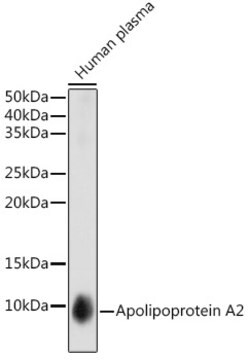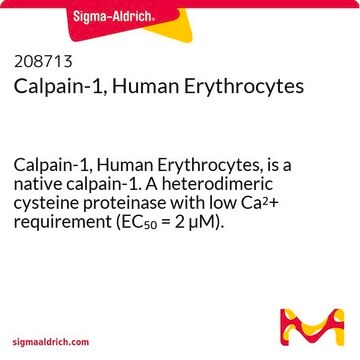SRP6306
Azurocidin Neutrophil (Cationic protein 37) from human neutrophils
≥95% (SDS-PAGE)
Synonym(s):
Cationic antimicrobial protein CAP37, Heparin-binding protein
Sign Into View Organizational & Contract Pricing
All Photos(1)
About This Item
UNSPSC Code:
12352200
NACRES:
NA.32
Recommended Products
General description
The gene for azurocidin is located on the short arm of chromosome 19 and is in a cluster with the genes for proteinase 3 and elastase. All three proteins are serine protease homologues; azurocidin, however, lacks enzymatic activity. It is an antibiotic protein, with monocyte chemotactic and antibacterial activity. The Azurophil granules, specialized lysosomes of the neutrophil, contain at least 10 proteins implicated in the killing of microorganisms. Azurocidin is a member of the serine protease family that includes Cathepsin G, Neutrophil Elastase (NE), and Proteinase 3 (PR3), however, Azurocidin is not a serine proteinase since the active site serine and histidine residues are replaced. Azurocidin has been identified as a modulator of endothelial permeability and an important multifunctional inflammatory mediator. Neutrophils arriving first at sites of inflammation release Azurocidin which acts in a paracrine fashion on endothelial cells causing the development of intercellular gaps and allowing leukocyte extravasation. Azurocidin thus be regarded as a reasonable therapeutic target for a variety of inflammatory disease conditions.
Physical form
Salt-free lyophilized solid.
Reconstitution
Use deionized water
Storage Class Code
13 - Non Combustible Solids
WGK
WGK 3
Flash Point(F)
Not applicable
Flash Point(C)
Not applicable
Certificates of Analysis (COA)
Search for Certificates of Analysis (COA) by entering the products Lot/Batch Number. Lot and Batch Numbers can be found on a product’s label following the words ‘Lot’ or ‘Batch’.
Already Own This Product?
Find documentation for the products that you have recently purchased in the Document Library.
Our team of scientists has experience in all areas of research including Life Science, Material Science, Chemical Synthesis, Chromatography, Analytical and many others.
Contact Technical Service







